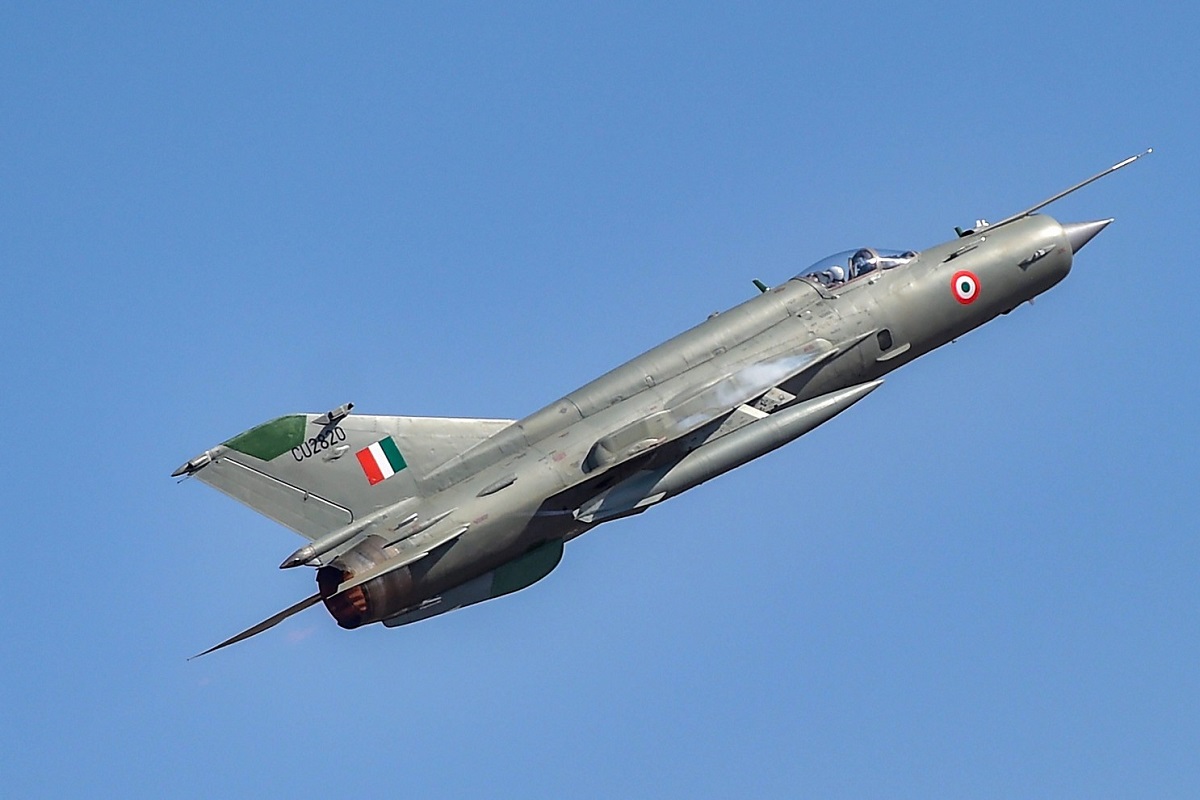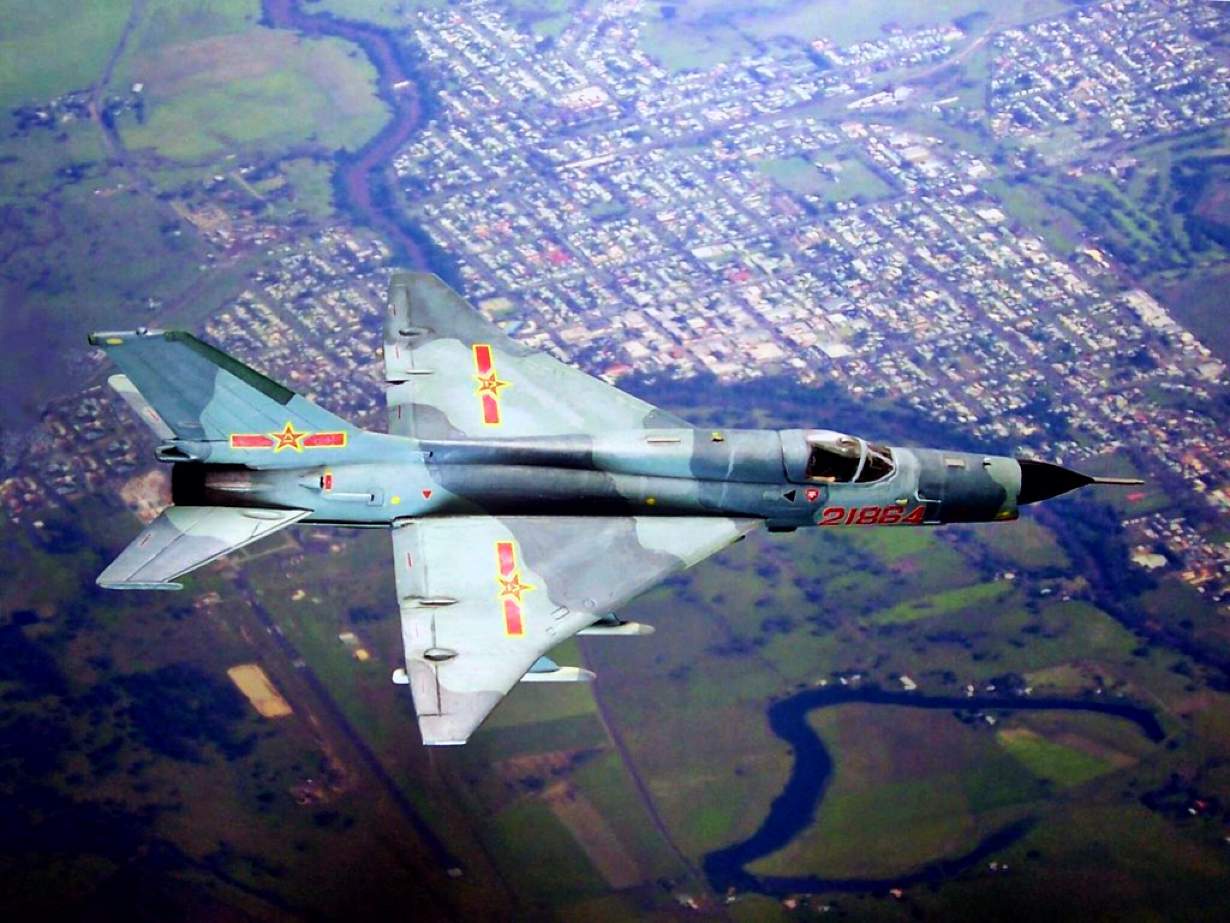The PLA Air Force’s (PLAAF) archaic J-7 fighter jet, which has been flying for several decades and has been produced in several variants, is finally slated to be decommissioned this year.
China started to retire the J-7 in earnest since the year 2018. However, Chinese experts have now opined that the legacy aircraft may be decommissioned entirely from the Chinese People’s Liberation Army (PLA) Air Force this year, state-run Global Times reported.
The reason cited for this is China’s burgeoning sophisticated fighter jet production.
The J-7 is a Chinese license-built version of the Soviet MiG-21 that made its maiden flight in 1966. With more than 400 J-7 fighters still in use, the aircraft maintains a high level of popularity despite its age. However, the MiG-21s have come of age and are being steadily retired by air forces worldwide.
For instance, the PLA Air Force’s rival in the region, the Indian Air Force (IAF), also announced last year that it would phase out all the MiG-21 fighter jets in its inventory by 2025.
The decision was triggered by a crash, even though the service has fewer fighter jets than its actual sanctioned squadron strength.

Further, the assertion about the aircraft’s decommissioning comes months after the PLA Air Force lost a J-7 fighter jet to an unfortunate crash. In June 2022, a PLAAF J-7 aircraft crashed into a residential building during training in Xiangyang, Hubei Province, killing one resident and injuring two.
The aircraft is notorious for several crashes that have dented its reputation over the years. Several F-7 operate globally.
In May 2022, two Iranian pilots were killed when their F-7 crashed near Anarak. Pakistan and Bangladesh Air Forces have also lost a few of these aircraft to crashes.
On its part, China Central Television (CCTV) stated on January 28 that the PLAAF has recently acquired a great deal of new equipment, with several units converting to fly cutting-edge, domestically manufactured fighter jets.
As of now, aging technology is gradually being decommissioned, which is why the time for J-7’s farewell has come.
The report comes days after Hong Kong-based South China Morning Post noted that the J-7 fighters would be replaced by more advanced J-16 fighter jets to combat stiffer challenges. Besides, it was announced that the J-16 aircraft had been deployed to all the theater commands of the PLA.
Earlier in January, a retired PLA Air Force equipment specialist, Fu Qianshao, told the state broadcaster, “Chinese old generation military aircraft like the J-7 and J-8 are not enough to deal with the increasing security challenges around its periphery.”
Chinese experts Du Wenlong told Global Times that the J-7 would likely be decommissioned from combat service by the PLA Air Force this year, owing to the rapid pace at which they are being phased out.
Further, several Chinese military experts predict that China will eventually replace older fighter jets like the J-7 with fifth-generation fighter jets like the J-20 and 4.5-generation fighter jets like the J-10C and J-16.
As for the age-old J-7 aircraft, analysts suggested that the retired J-7s could be used for training and testing or adapted to fulfill new purposes in contemporary warfare as drones.
Having said that, the J-7 fighter has significantly contributed to China’s air defense over the years.
The Iconic J-7 Fighters
These fighters are comparable to the aging MiG-21 jets used by the Indian Air Force. China produced all spare parts to facilitate the plane’s modernization and maintained a tightly controlled industrial environment.
China’s Chengdu Aircraft Corporation (CAC) created and built the single-engine, light fighter aircraft known as the J-7. Its design is based on the MiG-21 aircraft, and the export version is the F-7. The People’s Liberation Army Air Force was the main user of the J-7/F-7 during its reign.

The J-7 jet was built to carry out ground assault missions in any weather. Up to 2,000 kilograms can be loaded onto it as a payload. The J-7 is equipped with air-to-air missiles (AAM) such as the PL-2, PL-5, PL-7, PL-8, PL-9, Magic R.550, and AIM-9, unguided bombs weighing 50 kilograms to 500 kilograms, a 55mm rocket pod, and a 90mm rocket pod.
During the J-7’s 48-year production lifespan, more than a dozen different iterations were created. Chengdu developed trainer adaptations of the aircraft for domestic Chinese use, which were supplied to the PLA Air Force and the PLA Naval Air Force.
The original versions of the aircraft were upgraded technologically into the J-7PG and J-7BG series for Pakistan and Bangladesh.
The aircraft was also exported to countries in the Middle East and are operational with the Sudanese Air Force (22), Egyptian Air Force (90), Tanzanian Air Force (16), Yemen Air Force (18), Air Force of Zimbabwe (24), and the Islamic Republic of Iran Air Force. China’s neighboring countries, like Myanmar and North Korea, also operate the aircraft.
The J-7 aircraft have also seen combat during the civil wars in Sri Lanka, Uganda, and Sudan.
Last year, the aircraft surprised the West when it participated in drills near Taiwan, supported by more advanced fighter fighters. In Taiwan, the aircraft is frequently referred to as the “grandpa fighter jet.”
A report by the Mitchell Institute for Aerospace Studies (MIAS) published last year stated that legacy aircraft like the J-7 could be turned into drones and used against Taiwan from forward airfields.
In fact, experts claim that some J-7s were converted into target drones since their radar cross-section images were comparable to Taiwanese IDF planes and US-made F-16s, potentially deceiving air defenses.
So, while the J-7 fighter jets are being steadily decommissioned from PLAAF combat service, they may still linger around for a while.
- Contact the author at sakshi.tiwari9555 (at) gmail.com
- Follow EurAsian Times on Google News




